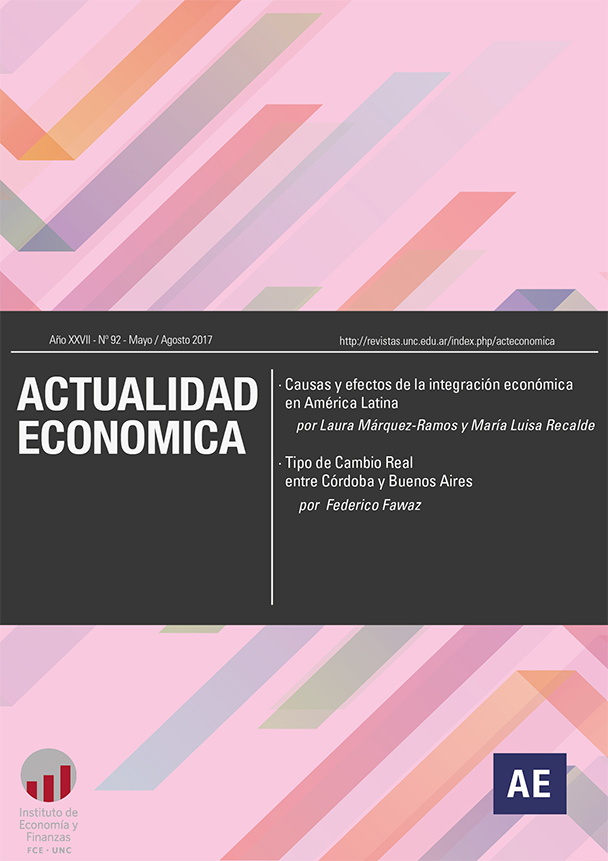Real Exchange Rate between Cordoba and Buenos Aires
Keywords:
Real Exchange Rate, Regional Markets, Cordoba, Buenos AiresAbstract
The objective of this work is to study the differences in the price structure between Córdoba and Buenos Aires. In general terms, the higher cost of living in Buenos Aires than in the interior of the country. Due to the high integration of national regional markets, tradable goods do not present major price discrepancies, which are observed in nontradables. The terms of trade and productivity differences between regions, through their impact on relative wages, stand out as the main determinant of the Real Exchange Rate. To a lesser extent, asymmetries in public policies and differences in population densities also have an impact on the regional price structure.Downloads
References
Arrufat, J. L., Capello, M. y Figueras, A. (2008). “La dinámica de crecimiento en las economías provinciales: un análisis de largo plazo”. Revista Cultura Económica 72, agosto, UCA, Buenos Aires.
Balassa, B. (1964). “The Purchasing Power Parity Doctrine: A Reapprisal”. Journal of Political Economy, diciembre.
Baumol, W. y Bowen, W. (1966). Performing arts: The economic dilemma, Nueva York: The Twentieth Century Fund.
Berka, M., Devereux, M. y Engel, C. (2014). “Real Exchange Rates and Sectoral Productivity in the Eurozone”. National Bureau of Economic Research, Documento de Trabajo Nro. 20510.
Bureau of Economic Analysis, Regional Economic Accounts.
Cassel, G. (1918). “Abnormal Deviations in International Exchanges”. Economic Journal, diciembre.
Dornbusch, R. (1985). “Purchasing Power Parity”. National Bureau of Economic Research, Documento de Trabajo Nro. 1591.
Dornbusch, R., Fischer, S. y Samuelson, P. (1977). “Comparative Advantage, Trade and Payments in a Ricardian Model with a Continuum of Goods”. American Economic Review, diciembre.
El Noble, Catálogo de precios online.
Engel, C. y Rogers, J. (1995). “How Wide is the Border?”. National Bureau of Economic Research, Documento de Trabajo Nro. 4829.
Frenkel, J. (1981). “The Collapse of Purchasing Power Parities during the 1970´s”. European Economic Review, mayo.
Froot, J. y Rogoff, K. (1991). “The EMS, the EMU, and the Transition to a Common Currency”. National Bureau of Economic Research, Documento de Trabajo Nro. 3684.
INDEC. Censo 2010.
INDEC. Metodología IPC GBA 1999.
INDEC. Paridades de Poder de Compra del Consumidor. Febrero de 2002.
Keynes, J. M. (1923). A Tract on Monetary Reform. MacMillan and St. Martin´s Press for the Royal Economic Society, 1971.
Ong L. L. (1997). “Burgernomics: The Economics of the Big Mac Standard”. Journal of International Money and Finance, diciembre.
Ricardo, D. (1817). On the Principles of Political Economy and Taxation. editado por P. Sraffa, Londres, 1951.
Rodríguez, C. y Sjaastad, L. (1979). “El Atraso Cambiario en Argentina, ¿mito o realidad?”. Universidad del CEMA, Documento de Trabajo Nro. 2.
Rogoff, K. (1996). “The Purchasing Power Parity Puzzle”. Journal of Economic Literature, junio.
Revista The Economist, The Big Mac Index.
Downloads
Published
Issue
Section
License
Those authors who have published with this journal, accept the following terms:
Authors will conserve their copyright and guarantee the magazine the right of first publication of their work, which will be simultaneously subject to the Creative Commons Attribution-NonCommercial-NoDerivative 4.0 International License that allows third parties to share the work as long as the author and first publication of this magazine are indicated.
Authors may adopt other non-exclusive license agreements to distribute the published version of the work (e.g., deposit it in an institutional telematic archive or publish it in a monographic volume) provided that the initial publication in this journal is indicated.
Authors are allowed and encouraged to disseminate their work through the Internet (e.g., in institutional telematic archives or on their website) before and during the submission process, which may lead to interesting exchanges and increase citations of the published work. (See The effect of open access)









